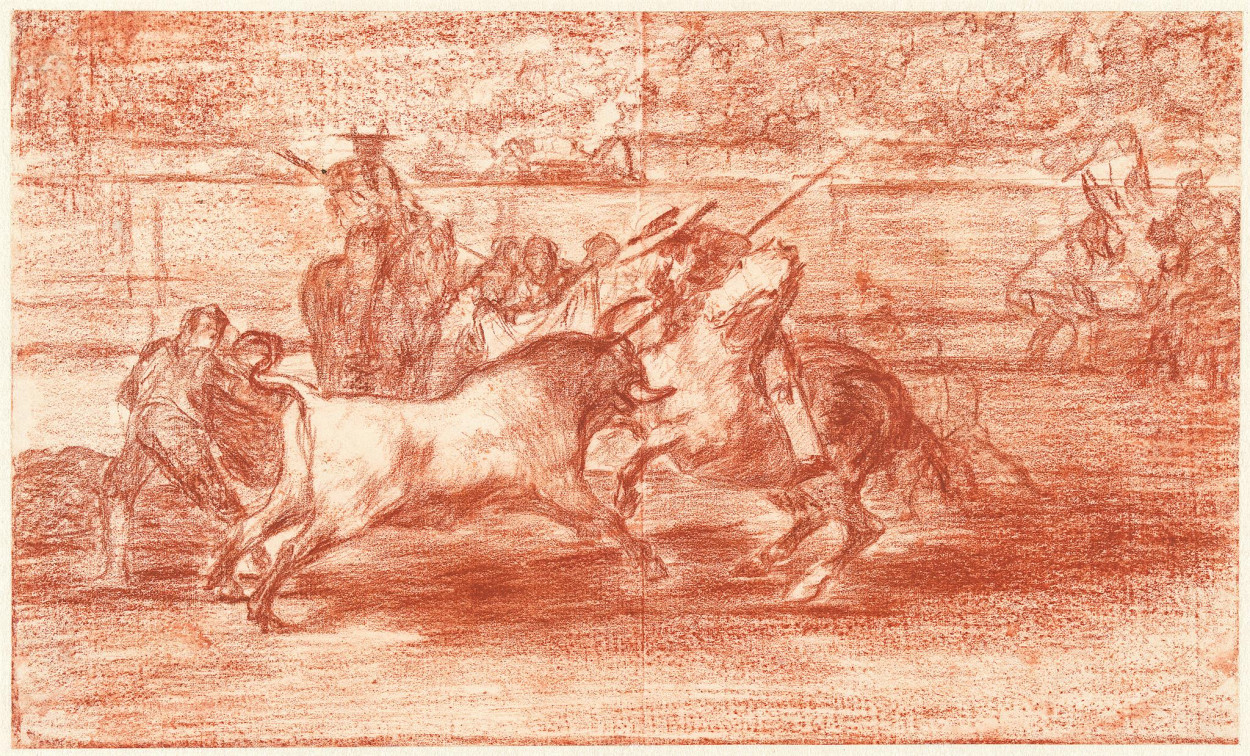
Francisco José de Goya y Lucientes, Zeichner
Rendón verwundet einen Stier mit der Pike tödlich - Vorzeichnung zur "Tauromaquia", Platte 28, 1815 - 1816
In its technical, formal, and material aspects, this drawing resembles the preparatory sketches for Francisco de Goya's Tauromaquia series from the Valentín Carderera Collection, now at the Museo Nacional del Prado. Like the other three at the Hamburger Kunsthalle (inv. nos. 38541, 38533, and 38542, cat. nos. 64, 65, and 66), it probably originated with Juan Agustín Ceán Bermúdez, a friend of Goya who likely advised the artist while he was creating the series, proposing titles, ordering the prints, and possibly recommending texts on which to base his works.[1] That may explain why, along with a bound copy of the series now at the British Museum in London, Goya gave Ceán Bermúdez those four preparatory drawings. It also clarifies their separation from the rest, which Goya kept and left to his grandson, Mariano, who sold them to Valentin Carderera (1796–1880) around 1861. Carderera kept them until his death in 1880, after which his nephew, Mariano, sold them to the Museo del Prado. Partially due to this different provenance, and because he was unable to see the original and had to judge by Loys Delteil's reproduction,[2] Enrique Lafuente Ferrari expressed doubts about the authenticity of this drawing, which he called “a mere imitation that draws on some of Goya's drawings; showing particular affinities with those of plates 10, 23, 40 (G) and 43 (J).”[3] Studies of the original, however, reveal the quality of the drawing and the unmistakable hand of Goya himself. The varied use of red chalk shows technical mastery, from the pointed pencil that was used to depict the bull's skin or the horses' heads, to the thick, intense strokes that allowed the artist to clearly outline the figures' contours. This is particularly relevant in a preparatory sketch: when it is placed in the press to transfer the image to the plate, those are the lines that have to leave their mark on the latter's surface for the artist's engraving. Moreover, the dimensions of the figures in the drawing exactly correspond to those on the plate. At the same time, the application of the flat side of the red-chalk bar to cover large areas of the paper allowed Goya to plan the later distribution of the aquatints, creating the light and shadow effects so characteristic of this series.
The center of attention to which Goya led the viewer's gaze is perfectly defined in this drawing. The red-chalk image occupies the entire surface of the paper, and the artist masterfully exploited the expressive possibilities of contrasting light by leaving the paper untouched in the parts that receive light and sketching in the shadows with dense strokes. Two opposing figures, the bull and the horse with its picador, violently collide and wound each other; the bull gores the horse's chest with its right horn, and the picador thrusts the point of his lance into the bull's hump. The compositional confusion that could have resulted from the use of only red and white is successfully resolved by alternating chromatic contrasts: the two animals are strongly lit, but Goya maintained the dark tones of the bull's head to emphasize its horn goring the horse.
According to Ricardo de Rojas, lancing from a rearing horse involved "allowing the bull to arrive at the lance while turning the horse slightly to the left. When the bull is in the middle of the act, he is not drawn away from it but is instead allowed to continue as far as the horse's left flank. At the same time, the horse is made to rear to the right, toward the bull's hindquarters, and flee."[4] Chronicles from the period mention the great number of horses that were gored in each bullfight, as horses wore no protective padding.
Francisco de Bruna y Ahumada, a judge at the Royal Court in Seville as well as an antiquarian and bibliophile, sent the following commentary to José de Vargas Ponce while the Disertación was being written:
"as I have already said, very few are the bullfights in which there is no notable tragedy requiring carrying the dead or seriously injured from the plaza. The most straightforward and well-known proof is the roomful of surgeons prepared to give first aid and the two extra picadors who are always present to take over when one of the others is injured. One continuously sees them being carried out of the ring without knowing whether they are dead or only injured. Some go home to recover, and other poor souls return to the ring, remaining on their horses as best they can so as not to lose their wages."[5]
This tragedy is the subject of other prints from the series, in which the goring takes place in the presence of members of the bullfighter's retinue who observe the violent encounter between bull and horse with a sense of impotence—some even appear indifferent. The public fills the seats, but rather than individual faces, we are presented with a uniform, anonymous mass whose presence endorses the spectacle of death.
José Manuel Matilla
1 A summary of these subjects appears in Matilla and Medrano 2001, 115-39.
2 Delteil 1922, no. 251.
3 Lafuente Ferrari 1946, 203-4.
4 Ricardo de Rojas y Solis, Marqués de Tablantes, Anales de la Real Plaza de Toros de Sevilla. 1730-1835 (Seville, 1927), 228-29.
5 José de Vargas Ponce, Disertación sobre las corridas de toros. Edition ordered and revised by Julio F. Guillén y Tato. Archivo documental español, vol. XVII. Madrid, Real Academia de la Historia, 1961, 395-96.
